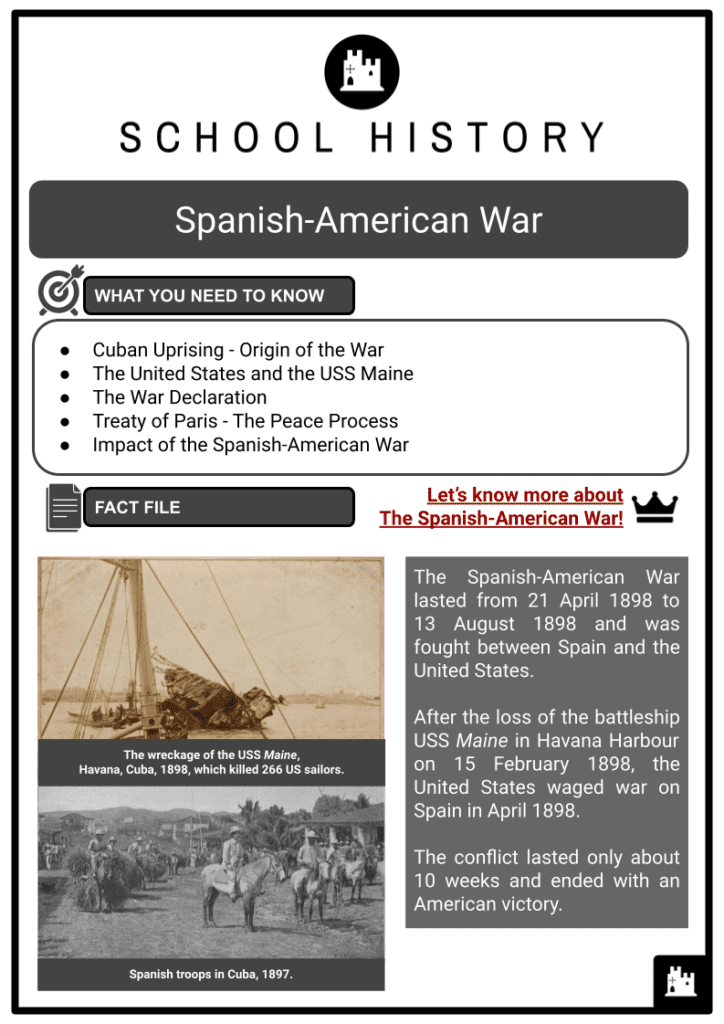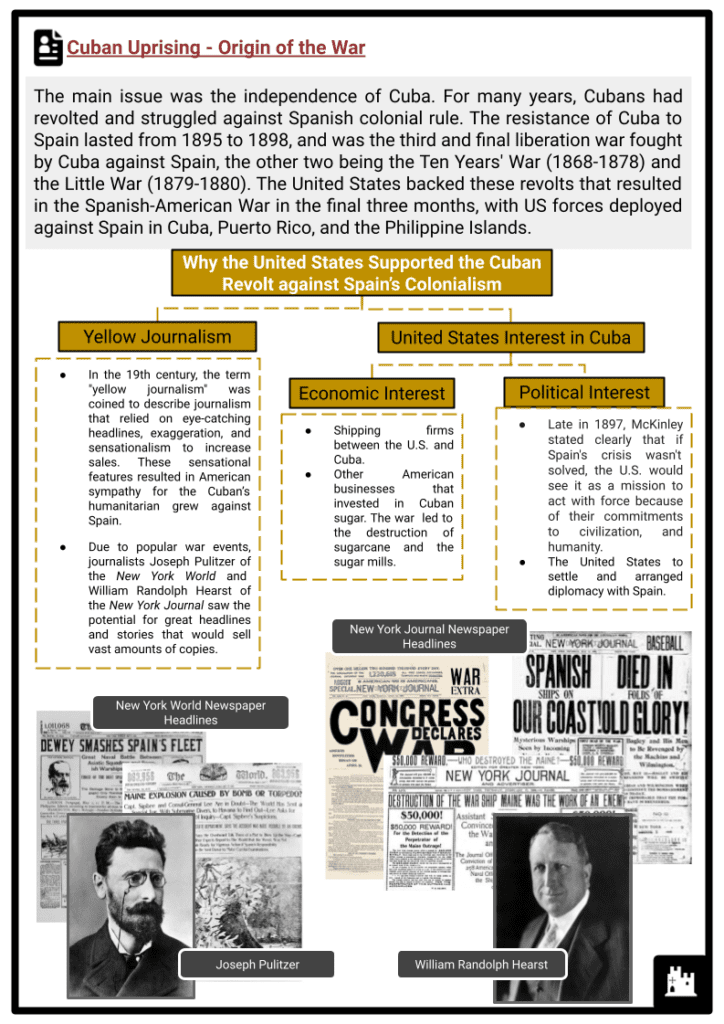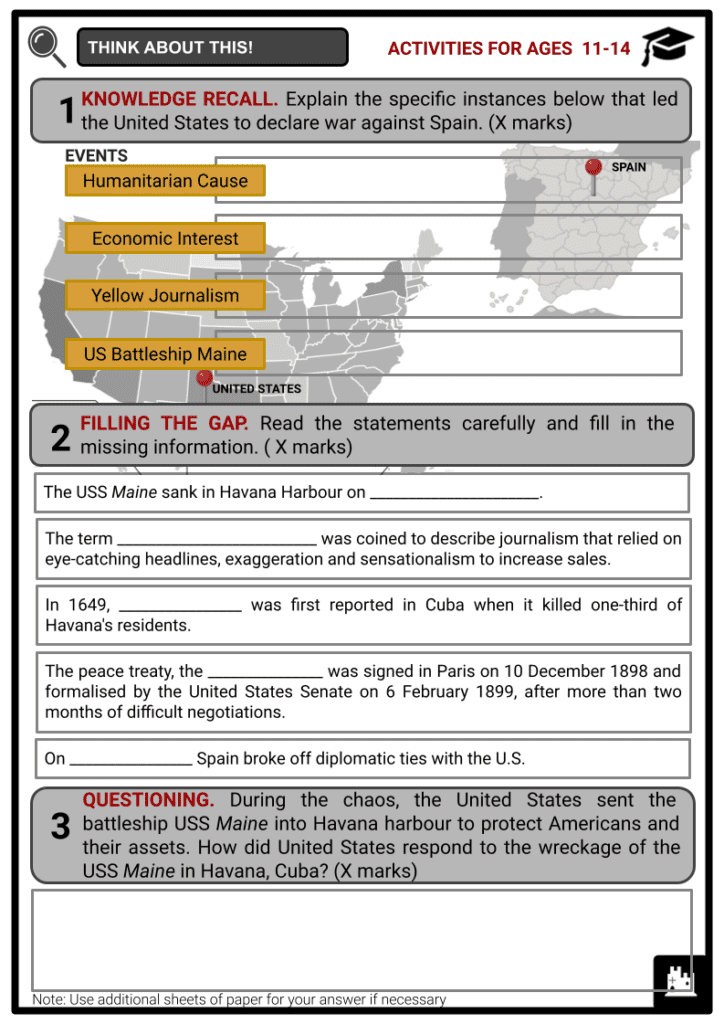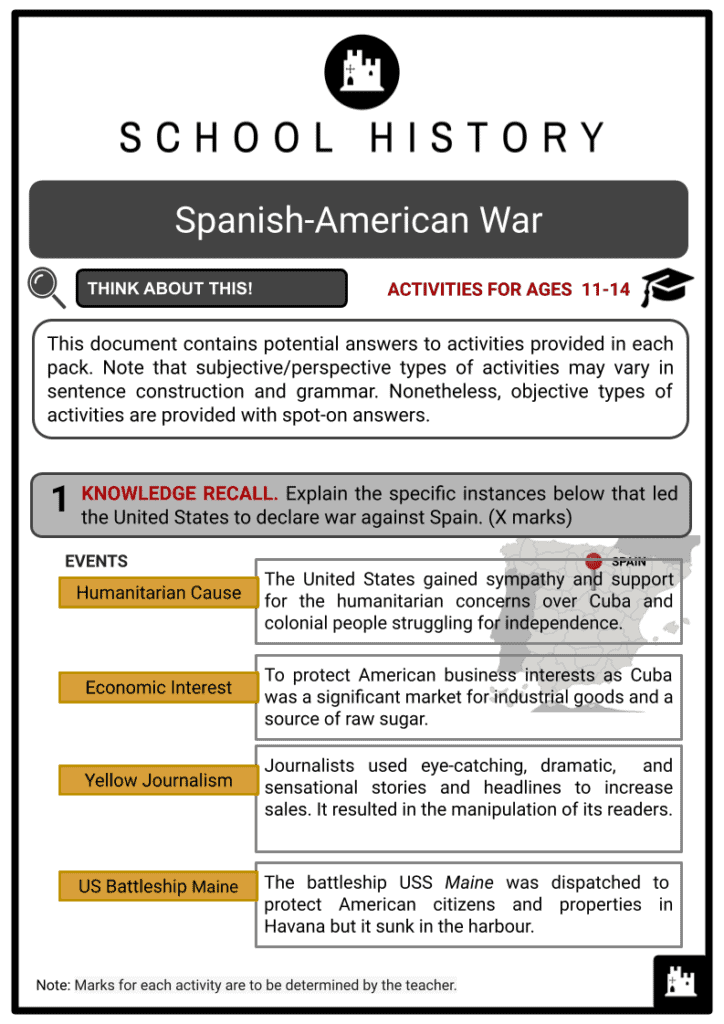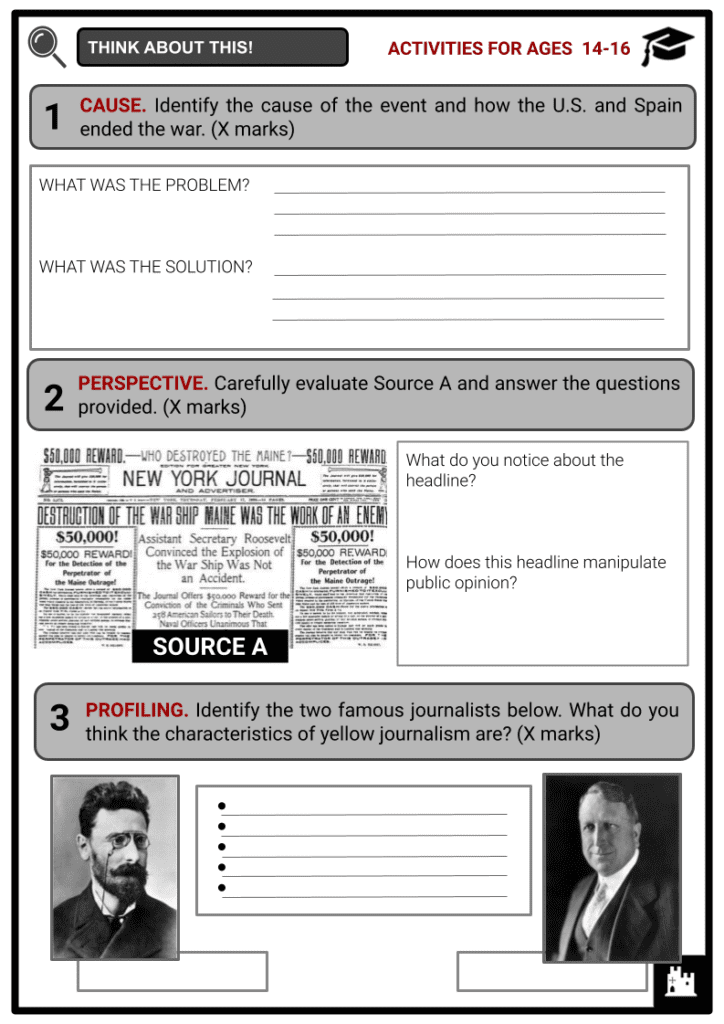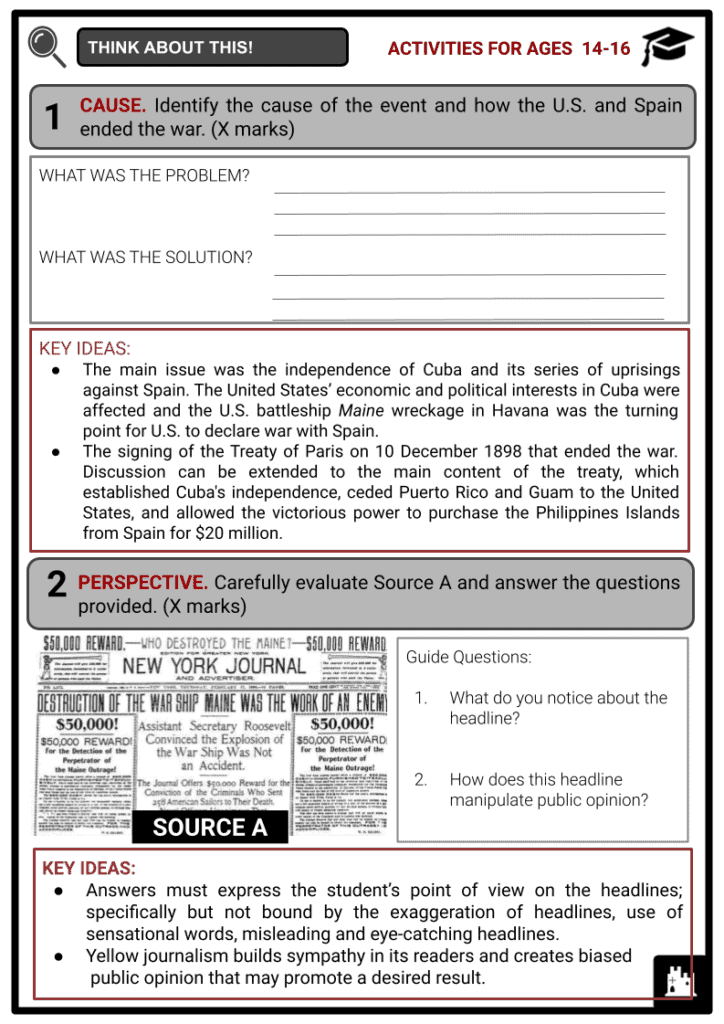Spanish-American War Worksheets
Do you want to save dozens of hours in time? Get your evenings and weekends back? Be able to teach about the Spanish-American War to your students?
Our worksheet bundle includes a fact file and printable worksheets and student activities. Perfect for both the classroom and homeschooling!
Summary
- Cuban Uprising - Origin of the War
- The United States and the USS Maine
- The War Declaration
- Treaty of Paris - The Peace Process
- Impact of the Spanish-American War
Key Facts And Information
Let’s find out more about the Spanish-American War!
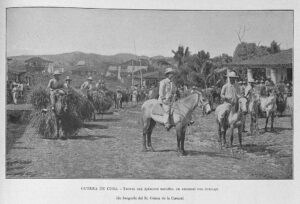
The Spanish-American War lasted from 21 April 1898 to 13 August 1898 and was fought between Spain and the United States. After the loss of the battleship USS Maine in Havana Harbour on 15 February 1898, the United States waged war on Spain in April 1898. The conflict lasted only about 10 weeks and ended with an American victory.
Cuban Uprising - Origin of the War
- The main issue was the independence of Cuba. For many years, Cubans had revolted and struggled against Spanish colonial rule. The resistance of Cuba to Spain lasted from 1895 to 1898, and was the third and final liberation war fought by Cuba against Spain, the other two being the Ten Years' War (1868-1878) and the Little War (1879-1880). The United States backed these revolts that resulted in the Spanish-American War in the final three months, with US forces deployed against Spain in Cuba, Puerto Rico, and the Philippine Islands.
Why the United States Supported the Cuban Revolt against Spain’s Colonialism
- Yellow Journalism
-
- In the 19th century, the term "yellow journalism" was coined to describe journalism that relied on eye-catching headlines, exaggeration, and sensationalism to increase sales. These sensational features resulted in American sympathy for the Cuban’s humanitarian grew against Spain.
- Due to popular war events, journalists Joseph Pulitzer of the New York World and William Randolph Hearst of the New York Journal saw the potential for great headlines and stories that would sell vast amounts of copies.
- United States interest in Cuba
- Shipping firms between the U.S. and Cuba. Other American businesses that invested in Cuban sugar. The war led to the destruction of sugarcane and the sugar mills.
- Late in 1897, McKinley stated clearly that if Spain's crisis wasn't solved, the U.S. would see it as a mission to act with force because of their commitments to civilization, and humanity.
- The United States to settle and arranged diplomacy with Spain.
The United States and the Maine
- President McKinley, well aware of the political complexities surrounding the conflict, desired a peaceful resolution with Spain to end the revolt. He began to negotiate with the Spanish government in the hope that the talks would dampen yellow journalism in the U.S. and soften support for war with Spain. Before McKinley took office, an attempt was made to reach a peace agreement. The Spanish, on the other hand, refused to participate in the negotiations.
- In 1897, Stewart L. Woodford was appointed by McKinley as the new minister to Spain, to offer and negotiate peace with Spain. In October 1897, the Spanish government declined the United States's offer to mediate negotiations between the Spanish and Cubans but made a promise to the United States that it would provide the Cubans greater autonomy.
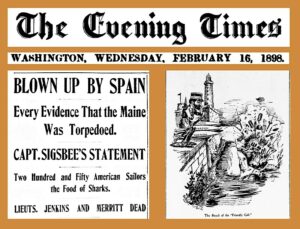
Despite the fact that a U.S. Navy investigation report would take a month to be published, The Washington D.C. newspaper was among those who claimed within one day that the explosion was not accidental. - In response to riots in Havana in December, the battleship Maine was dispatched to its port as a safety measure for American citizens and property.
- In 1898, the Maine sank in Havana Harbour on 15 February 1898. The explosion took the lives of more than 3/4 of the 355 sailors, officers, and marines who made up the ship's crew. Only 16 of the 94 survivors were uninjured.
- The initial explosion resulted in the deaths of 260 men, and six more died from their wounds. This was the greatest loss of life for the American forces in a single day since the defeat at Little Bighorn 20 years earlier.
- While McKinley urged patience and did not blame Spain for the explosion, the deaths of hundreds of American sailors captured the public's attention. McKinley requested that Congress appropriate $50 million for defence, and Congress agreed unanimously. The majority of American leaders thought the cause of the explosion was unknown.
- On 21 April, Spain broke off diplomatic ties with the U.S. The United States Navy started a blockade of Cuba on the same day. Spain responded to the blockade by declaring war on the United States on 23 April.
- The U.S. Congress replied on 25 April by declaring that the U.S. and Spain had been in a state of war in effect since 21 April, when the blockade of Cuba started.
The War Declaration
- After its declaration of war against Spain was issued on 25 April 1898, the United States added the Teller Amendment announcing that the United States would not establish permanent control over Cuba.
- Meanwhile, across the Pacific Ocean, the Philippines was ruled by Spain for over 333 years. On 23 April 1898, a document from Governor General Basilio Augustin was published in the Manila Gazette, warning of the impending war and calling Filipinos to participate on Spain's side.
- The Teller Amendment was a joint resolution passed by the United States Congress in response to President William McKinley's War Message on 20 April 1898. It placed conditions on the military presence of the United States in Cuba. The clause states that the United States could not annex Cuba and must instead "leave control of the island to its people." In essence, the United States would assist Cuba in achieving independence and then withdraw all of its forces from the country.
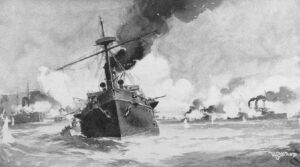
The Battle of Manila, 1898 - Commodore George Dewey sailed from Hong Kong two days later, with Emilio Aguinaldo on board. On 1 May, the Battle of Manila Bay began in the Philippines Islands. The Asiatic Squadron led by Commodore George Dewey destroyed the Spanish fleet and captured Manila's harbour.
- By 9 June, Aguinaldo's forces had taken control of the provinces of Bulacan, Cavite, Laguna, Batangas, Bataan, Zambales, Pampanga, Pangasinan, and Mindoro, as well as the city of Manila. On 12 June, Emilio Aguinaldo declared the Philippines independence.
- While on the Caribbean side, Theodore Roosevelt advocated intervention in Cuba for the benefit of the Cuban people as well as to advance the Monroe Doctrine.
- In the mainland of Latin America, Cuba was the first to initiate its own independence struggle from Spain. Between 1868 and 1878, Cuban guerrilla fighters known as mambises fought for independence from Spain. The Americans planned the destruction of Spain's army forces in Cuba, capture Santiago de Cuba, and destroy the Spanish Caribbean Squadron (known as the Flota de Ultramar). They had to navigate the heavily fortified Spanish strongholds in the San Juan Hills and a small village in El Caney to get to Santiago. The American forces were aided in Cuba by the pro-independence rebels led by General Calixto García.
- On 25 May 1898, Henry Cabot Lodge wrote a letter to Theodore Roosevelt saying, "Porto Rico is not forgotten and we mean to have it".
- Puerto Ricans created several political parties in the 1880s and 1890s, some of which supported the island's independence, while others, with headquarters in New York like their Cuban counterparts, chose to build alliances with the U.S. Spain granted Puerto Rico autonomy on 25 November 1897, but the island was not informed until January 1898, and a new administration wasn't put in place until 12 February.
The Fight Against Disease….
- In 1649, yellow fever was first reported in Cuba when it killed one-third of Havana's residents. From 1856 to 1879, the disease struck nearly every month in the city. Foreign occupiers were especially vulnerable; between 1895 and 1898, an estimated 16,000 Spanish troops died from yellow fever.
- At the start of the war with the United States, illness had destroyed the Spanish fighting force, with only 55,000 troops healthy enough to fight out of an entire army of 230,000.
- Officials in the United States were aware of the dangers of the disease. Army Major Walter Reed, a physician who would later head the United States Army Yellow Fever Board in Cuba, advised a friend who was about to deploy there. Reed wrote that a "plug of cotton in the nostrils would be advisable" if the yellow fever germ was inhaled.
- During the war, fewer than 400 American soldiers were killed in action. However, over 2,000 people were infected with yellow fever during the campaign. Disease, according to General William Shafter, was "a thousand times more difficult to resist than enemy missiles."
Treaty of Paris
- Spain sought peace, and the two sides started negotiating after it suffered defeat in Cuba and the Philippines and had its fleets destroyed in both locations. Following the illness and death of British consul Edward Henry Rawson-Walker, American admiral George Dewey asked the Belgian consul in Manila, Édouard André, to act as an intermediary between the Spanish government and the United States.
- The signing of a Protocol of Peace between the United States and Spain in Washington on 12 August 1898 ended the fighting. The peace treaty, the Treaty of Paris, was signed in Paris on 10 December 1898 and formalised by the United States Senate on 6 February 1899, after more than two months of difficult negotiations.
- The peace treaty in Paris established Cuba's independence, ceded Puerto Rico and Guam to the United States, and allowed the victorious power to purchase the Philippines Islands from Spain for $20 million. The war had cost the United States $250 million and 3,000 lives, with infectious diseases killing 90% of those who died.
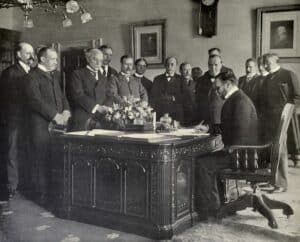
Ratification of the Treaty of Paris - On 11 April 1899 the Treaty of Paris came into effect, when the documents of ratification were exchanged. It was the first treaty negotiated between the two governments since the Adams-Onís Treaty of 1819.
- More precisely, the treaty addressed the following topics in seventeen articles:
- Article 1 - Spanish renunciation of claim to Cuban sovereignty and American occupation of Cuba
- Article 2 - Puerto Rico and Guam were ceded by Spain to the United States
- Article 3 - Spanish ceding the Philippines to the United States in exchange for a payment of $20,000,000
- Article 4 - Spanish shipping in the Philippines
- Article 5: Return of Spanish soldiers and sailors captured at Manila, withdrawal of Spanish forces from the Philippines and Guam, and disposition of Spanish weapons, supplies, and equipment.
- Article 6 - Calls for the release of all prisoners, including those implicated in the uprisings in Cuba and the Philippines. The U.S. is obligated to follow suit and to encourage the uprising's forces to do the same.
- Article 7 - Both parties must renounce all claims of damage
- Article 8 - Forts and other permanent structures, records, and private property are covered
- Article 9 - Rights of Spanish nationals and indigenous peoples on territory they have ceded
- Article 10 - Religious liberty
- Article 11 - Courts
- Article 12 - Judiciary actions
- Article 13 - Creative works, patents, and copyrights
- Article 14 - Spanish authority to designate consular posts
- Article 15 - Rights of merchant boats
- Article 16 - Cuba after U.S. occupation
- Article 17 - Ratification of Treaties
Impact of the Spanish-American War
- In the United States…
- The U.S. became a global power after winning the Spanish-American War because gaining control of Guam, Puerto Rico and the Philippines increased its economic dominance in the Pacific. The impact of its expansion of U.S. foreign and economic policy persisted well into the following century. Additionally, McKinley's substantial contribution to the treaty's passage changed the presidency from a lesser post to a model for the stronger presidency that is more prevalent today.
- A canal developed by the United States would traverse the Panama Isthmus as a result of the war. In 1914, the Panama Canal, which connects the Atlantic and Pacific oceans, was completed.
- The rise of Theodore Roosevelt – He stands out among all the characters who took part in the Spanish American War as the most noteworthy. As a New York state assemblyman, New York City police commissioner, civil service commissioner, and assistant secretary of the navy, Roosevelt had already advanced quickly in his career.
- After the short and successful Spanish-American War, the public's perception of American imperialism changed. Because of the United States' strong diplomatic and military influence, Cuba's postwar status was highly dependent on American actions. The Spanish-American War resulted in two significant developments: one, it solidified American perceptions of themselves as "defenders of democracy" and a major world power; and two, it had serious implications for future Cuban-American relations. According to historian Louis Pérez, in his book Cuba in the American Imagination: Metaphor and the Imperial Ethos, the Spanish-American War of 1898 defined how Americans came to think of themselves as righteous people given to the service of a righteous purpose.
- In Spain….
- As a result of this ordeal, a new cultural movement known as the Generation of '98 emerged, resulting in a renaissance in Spanish culture. Spain gained economically during the war because after it ended, enormous quantities of money that Spaniards had in Cuba and the United States were brought back to the peninsula and invested in Spain.
- Large contemporary companies in Spain's steel, chemical, financial, mechanical, textile, shipbuilding, and electrical power industries all grew as a result of this enormous capital inflow, which equalled 25% of the country's annual gross domestic product. The political repercussions, however, were severe. The fragile political stability that had been achieved earlier under the leadership of Alfonso XII started to deteriorate after the war's defeat.
- The Generation of '98, also known as the Generation of 1898, was a group of writers, poets, essayists, and philosophers active in Spain during the Spanish-American War (1898). They were committed to cultural and aesthetic renewal and were associated with modernism. José Martinez Ruiz (also known as "Azorn") coined the term in his 1913 essays titled "La generación de 1898," referring to the moral, political, and social crisis in Spain caused by the loss of the colonies of Cuba, Puerto Rico, the Philippines, and Guam following defeat in the Spanish-American War.

